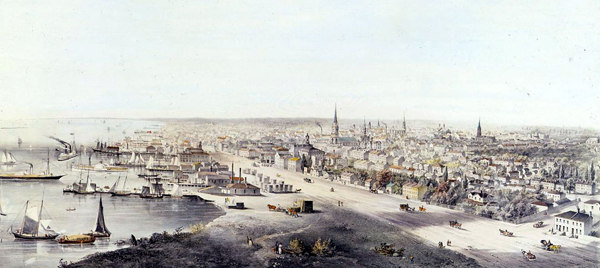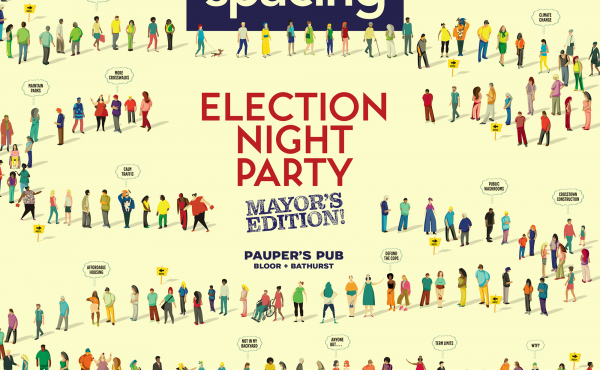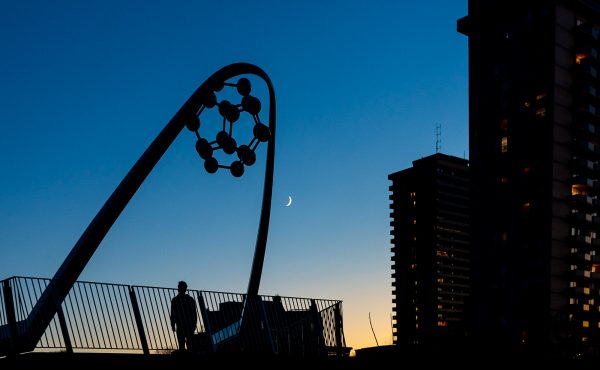EDITOR: This is the second post of a new collaboration with the Toronto Dreams project by Adam Bunch (see the first here). The project is a series of postcards hidden around the city for people to randomly find. On the cards are strange, fictional dreams set in the place the postcard was left. We will be cross-posting from the project’s Historical Ephemera Blog, a place where things Adam discovered during his research, like stories about duels and bank robbers and 100-year-old fish, are collected.
This article was updated in October 2023 to incorporate newly discovered information.
These weren’t the kind of clowns you want to mess with. They were, by all accounts, a pretty rough crew. They were in town for just a couple of days — part of a touring show from the U.S. called S.B. Howes’ Star Troupe Menagerie & Circus. Along with the clowns, there were acrobats and equestrian trick riders and a bunch of exotic animals: big cats, elephants, even a giraffe. The circus had already performed a two shows that day — it was a rare big draw in a city that was just starting to come into its own.
This was the summer of 1855. And Toronto was growing very, very quickly. Forty thousand people lived in the city now — and new immigrants were flooding in all the time. With the very first railways starting up, the population would double over the next 20 years.
But in a lot of ways, it was still a rough, pioneer town. It would be a long while before we got our reputation for being Toronto The Good. If anything, we were the opposite. There were 68 taverns along Yonge Street — an average of one every 1200 meters between here and Barrie. In the city itself, there were 152 of them. Plus 203 beers shops on top of that. And then, there were the brothels. We had a lot of brothels.
The circus was done for the day and the clowns had the rest of the night off, so they decided to take advantage of the local nightlife. They picked a brothel near the corner of King & John and settled in to have some fun. But the rest of the night wouldn’t go as planned.
It seems the clowns picked the wrong brothel. This one was a hangout for some of the men in a local volunteer fire brigade: The Hook & Ladder Firefighting Company. And these weren’t the kind of firefighters you wanted to mess with either. In those days, there was no central, public, government-run fire department. When a fire broke out, all the companies who were nearby rushed to the scene with their horse-drawn engines to get there first and call dibs. Just a couple of weeks earlier, the Hook & Ladders had arrived at a fire on Church Street at the same time as another brigade. A fight broke out. As the building burned, the firefighters rioted in the street and looted the homes they were meant to be saving. When the police showed up, they got pulled into the brawl too. In the end, the firefighters were charged with assault. And the battle became known as the Firemen’s Riot. The Hook & Ladders were no strangers to violence.
No one seems to agree on exactly how the fight at the brothel got started. Some blame a particularly loudmouthed clown. Some say the clowns cut in line — or knocked the hat off a firefighter’s head. But this much is clear: that night, the clowns kicked some firefighting ass. At least two of the firefighters were seriously injured, dragged out of the brothel to safety as the Hook & Ladder crew retreated. For the rest of the night, the clowns could drink and have sex in peace.
But it wasn’t over yet. Those firemen had a lot of friends. In those days, Toronto was still pretty much entirely run by a small group of Protestant, Tory elites. They were all members of the Orange Order, hung out together at the Orange Lodge, and made sure that other Orangemen got all the important jobs in the city. The police were pretty much all Orangemen. And the firefighters were too. Usually, they focused on beating up Catholics. But they were willing to make an occasional exception.
The fight at the brothel came on the day of the big annual Orange parade, July 12. And the next day — a Friday the 13th, no less — a crowd began to gather around S.B. Howes’ Star Troupe Menagerie & Circus. An angry, Orange crowd. The troupe had pitched their tents at the Fair Green, a big grassy space on the waterfront, just a few blocks east of the St. Lawrence Market. (Now, it’s the south-east corner of Front & Berkeley.) The farmers and merchants who had set up stalls nearby were told to clear out. There was trouble brewing.
They say word reached the police before violence broke out. But of course the Chief of Police, Samuel Sherwood, was an Orangeman. That’s how he got to be Chief of Police. In fact, years earlier he’d helped to organize a conservative Tory attack on a liberal Reform Party parade. One of the Reformers had been shot and killed. So when Chief Sherwood heard about the trouble down at the Fair Green, he dragged his feet for as long as he could. And then, eventually, he sent a few men to check it out.
By the time they got there, it had started. People were throwing stones. While the circus performers and the carnies were apparently able to hold the mob off for a while, it couldn’t last. Eventually, the crowd overwhelmed them. And when the Hook & Ladders arrived, all hell broke loose. They stormed the circus with pikes and axes, overturned wagons, pulled down the tents and the Big Top and set fire to them. They beat clowns to a pulp. Circus folk ran for their lives. Some dove into the lake for safety. It was mayhem.
It took the Mayor to settle things down. He came to the Fair Green in person, is said to have kept a firefighter from killing a clown with an axe by grabbing it out of his hands, and called in the militia to take control of the situation. Once things had calmed down, the circus performers came back for their belongings and then ran like hell.
The police had done pretty much nothing. They just watched. Even Chief Sherwood himself had eventually shown up, but could only claim to have stopped the rioters from setting fire to the cages of the animals. Of the 17 people who were charged in the riot, only one was ever convicted. All of the police who were at the scene claimed they couldn’t remember any of the Orangemen who had been there. Just like they had a few weeks earlier, after the Fireman’s Riot on Church.
That, as far as most people were concerned, was a cover up. And they would keep on coming. A few years later, there was another Protestant vs. Catholic riot — and Chief Sherwood’s memory was again suspiciously fuzzy as far as Orangemen were concerned. A few months after that, he was under fire again after freeing a suspect who had been accused of robbing a bank.
It was a turning point. City council called for deep reforms to the way Toronto’s police force was run. The provincial government agreed. An inquest was launched, and given a boost when a Reform Party candidate was elected mayor for the first time in more than 20 years (since William Lyon Mackenzie’s rebellion). In the end, the whole old system was overthrown. Every single police officer in the city was fired and a new force was created from scratch. Nearly half of the old constables would end up being re-hired; it took nearly 100 years before the Orange stranglehold on power in Toronto was finally broken. But the foundations of our current, modern police force had finally been laid.
Cross-posted from The Toronto Dreams Project Historical Ephemera Blog.
Photo: Toronto in the 1850s, with edge of the Fair Green bottom-centre





